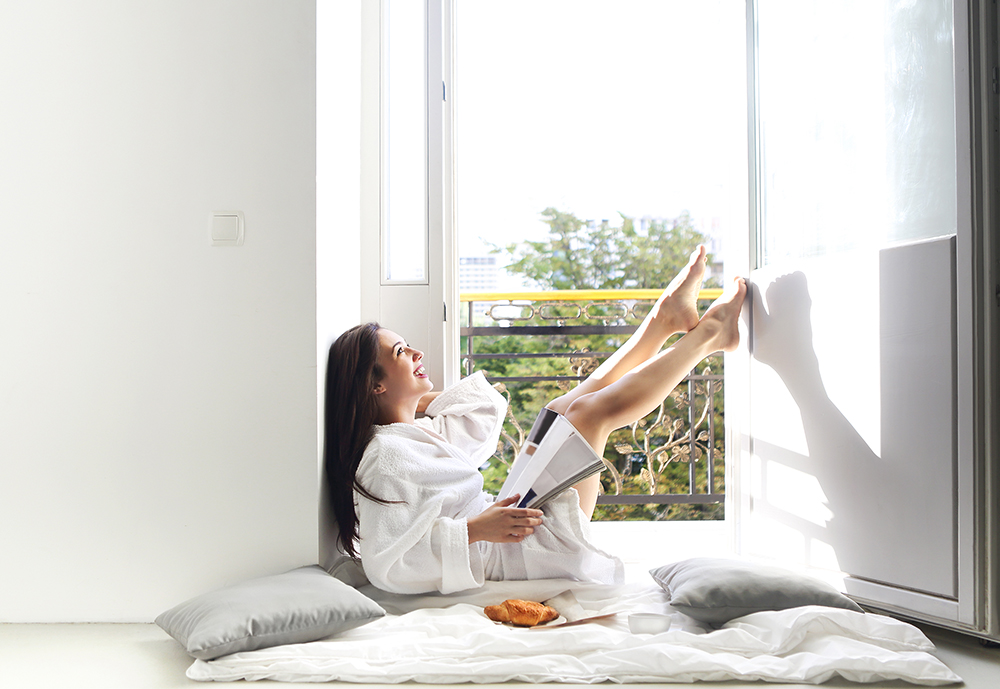

Life happens, and sometimes we find ourselves spending more time indoors than we'd like. Whether you're dealing with bad weather, recovering from illness, or simply choosing to stay home, being cooped up can take a toll on your mental wellbeing. The good news? You don't need to leave your space to lift your spirits and create a more positive atmosphere.
Your home environment plays a crucial role in how you feel throughout the day. With the right strategies, you can transform any indoor space into a mood-boosting sanctuary that energizes and inspires you. Here are twelve proven ways to brighten your day without stepping outside.
How you start your day sets the tone for everything that follows. Instead of reaching for your phone the moment you wake up, try establishing a morning routine that naturally boosts your energy levels.
Start with natural light exposure. Open your curtains or blinds as soon as you get up to signal to your brain that it's time to be alert. Even on cloudy days, natural light helps regulate your circadian rhythm and can improve your mood significantly.
Consider incorporating gentle movement into your morning routine. This doesn't mean an intense workout—simple stretching, yoga poses, or even dancing to your favorite song can release endorphins and increase blood flow. These activities help shake off grogginess and create a sense of accomplishment early in the day.
Don't underestimate the power of a mindful breakfast. Take time to prepare something nutritious and eat it without distractions. The act of nourishing your body mindfully can be surprisingly grounding and positive.
Lighting dramatically affects your mood and energy levels. Most indoor spaces rely heavily on overhead lighting, which can feel harsh and uninspiring. Instead, create layers of warm, inviting light throughout your home.
Use table lamps, floor lamps, and string lights to create a cozy atmosphere. Warm white bulbs (2700K-3000K) are particularly effective for creating a welcoming environment. If you have the option, invest in smart bulbs that can adjust throughout the day, mimicking natural light patterns.
Candles offer another excellent way to enhance your space's ambiance. The flickering light creates a calming effect, and scented candles can engage your sense of smell to further boost your mood. Choose uplifting scents like citrus, vanilla, or lavender depending on whether you want to energize or relax.
Connecting with nature doesn't require a backyard or balcony. Houseplants can significantly improve your indoor air quality while providing psychological benefits. Studies show that simply looking at greenery can reduce stress and improve focus.
Start with low-maintenance plants if you're new to plant care. Snake plants, pothos, and spider plants are forgiving options that thrive in various lighting conditions. Place them strategically around your living space where you'll see them frequently.
If you struggle to keep plants alive, consider fresh flowers or even high-quality artificial plants. The visual impact of greenery can still provide mood-boosting benefits.
Physical activity is one of the most effective mood enhancers available. You don't need a gym membership or fancy equipment to get your blood pumping and endorphins flowing.
Try bodyweight exercises like push-ups, squats, and lunges. These can be done in small spaces and provide excellent cardiovascular and strength benefits. YouTube offers countless free workout videos for every fitness level and space limitation.
Dance is another fantastic option. Put on your favorite upbeat music and move however feels good. Dancing combines physical activity with music, creating a double dose of mood-boosting benefits.
For something more meditative, consider yoga or tai chi. These practices combine gentle movement with mindfulness, helping you feel more centered and calm.
Designate a specific area of your home as your relaxation sanctuary. This doesn't need to be an entire room—even a corner with a comfortable chair and good lighting can work wonders.
Make this space as comfortable as possible with soft blankets, supportive pillows, and perhaps a small side table for your favorite books or tea. The key is creating a space that signals to your brain that it's time to unwind and recharge.
Keep this area clutter-free and dedicated solely to positive activities like reading, meditation, or gentle stretching. Having a designated relaxation zone helps you establish boundaries between different activities and moods throughout your day.
Your sense of smell is directly connected to the emotional center of your brain, making aromatherapy a powerful tool for mood enhancement. Essential oils can be used in various ways to create a more pleasant and uplifting environment.
Diffusers are the most popular method for dispersing essential oils throughout your space. Citrus oils like lemon and orange are excellent for boosting energy and mood. Lavender and chamomile are perfect for relaxation and stress relief.
If you don't have a diffuser, you can add a few drops of essential oil to a spray bottle with water to create a room spray. You can also place a few drops on a cotton ball and tuck it into your pillowcase or dresser drawer.
Mindfulness practices can significantly improve your mood and overall mental wellbeing. Meditation doesn't require special equipment or extensive training—even five minutes of focused breathing can make a difference.
Start with simple breathing exercises. Sit comfortably and focus on taking slow, deep breaths. When your mind wanders, gently bring your attention back to your breath. This practice helps activate your parasympathetic nervous system, promoting relaxation and reducing stress.
Guided meditation apps like Headspace or Calm can provide structure if you're new to meditation. Many offer free content and sessions specifically designed for mood enhancement and stress reduction.
Social connection is crucial for mental health, and technology makes it easier than ever to stay connected with friends and family. Schedule regular video calls with loved ones, join online communities related to your interests, or participate in virtual events.
Consider organizing virtual activities with friends like online game nights, movie watch parties, or cooking the same recipe together over video chat. These shared experiences can create meaningful connections and provide something to look forward to.
Don't overlook the power of written communication. Sending thoughtful texts, emails, or even handwritten letters can strengthen relationships and boost both your mood and the recipient's.
Creative expression is a powerful mood booster that engages different parts of your brain and provides a sense of accomplishment. You don't need to be artistic to benefit from creative activities.
Try activities like coloring, drawing, writing, crafting, or playing music. The key is finding something that feels enjoyable rather than stressful. Adult coloring books have become popular because they're accessible and meditative.
Cooking and baking can also be creative outlets. Experimenting with new recipes or decorating baked goods engages your creativity while providing tangible results you can enjoy.
Just as morning routines set a positive tone for your day, evening routines help you wind down and prepare for restorative sleep. Create a calming transition from day to night that signals to your body it's time to relax.
Start dimming lights about an hour before bedtime. This helps your brain begin producing melatonin, the hormone that regulates sleep. Avoid screens during this time, as blue light can interfere with your natural sleep cycle.
Consider activities like gentle stretching, reading, journaling, or listening to calming music. A warm bath with Epsom salts can be particularly relaxing and help ease any physical tension from the day.
Quality sleep is fundamental to mood regulation and overall wellbeing. Your bedroom environment plays a crucial role in how well you sleep and how you feel when you wake up.
Keep your bedroom cool, dark, and quiet. Blackout curtains or an eye mask can help block out light, while a white noise machine or earplugs can reduce disruptive sounds. The ideal temperature for sleep is between 60-67 degrees Fahrenheit.
Invest in comfortable bedding and pillows that support good sleep posture. Your mattress should be supportive and comfortable—if you wake up with aches and pains, it might be time for an upgrade.
Strong social connections are vital for mental health and mood regulation. Make an effort to maintain relationships even when you're spending more time at home.
Regular phone calls, video chats, or text conversations with friends and family can provide emotional support and help you feel less isolated. Share your experiences, listen to others, and maintain those important human connections.
Consider joining online communities or forums related to your interests. Engaging with like-minded people can provide a sense of belonging and community even when you're physically alone.
Creating a mood-boosting environment at home is about more than just decorating—it's about intentionally designing your space and routines to support your mental and emotional wellbeing. Small changes in lighting, scents, activities, and daily routines can have a profound impact on how you feel.
The key is to experiment with different strategies and find what works best for your lifestyle and preferences. Some people thrive with energizing morning workouts, while others prefer gentle evening yoga. Some find aromatherapy incredibly effective, while others prefer the mood-boosting effects of good lighting.
Remember that your living space should reflect your personality and support your wellbeing. If you're looking for apartments for rent in Wilson, NC, contact Oasis at Heritage today to schedule a personal tour. Finding the right home environment is the first step toward creating a space that truly supports your happiness and wellbeing.